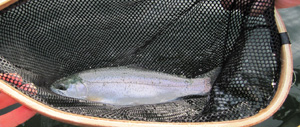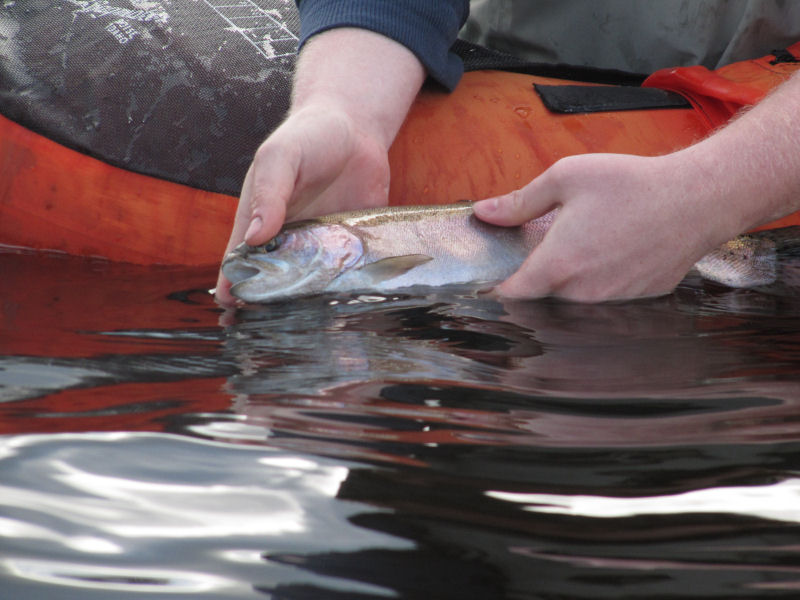Tungsten
A variety of tungsten fishing weights in various forms are available on the market today. Tungsten makes an excellent lead alternative because it is denser and heavier than lead and is widely available. It is available from most fishing retailers and online stores as various forms. Worm weights, bullet weights, flippin’ weights, drop shot weights and more are available for bass fishing. Besides the obvious advantage of a denser, heavier weight another great feature of tungsten is that colored dye can be added to increase the attractiveness of the presentation. Tungsten sinkers are available in different colors to match or contract your lure.
Tungsten fly fishing beads and soft tungsten putty are available for fly fishing use. Tungsten beads work great for flies because the heaviness of the material means that a smaller bead can be used than brass or lead but still give the fly the desired sink rate. Tungsten putty is a soft form of tungsten weight that comes in a small sealed container and can be rolled onto the line. After fishing simply pinch the putty off the line. If more weight is needed while fishing simply pinch a little bit more out of the container and roll it onto the line.
 Tru Tungsten worm weights
Tru Tungsten worm weights
Brass
Another good lead alternative sinker material is brass. Brass sinkers are available in various shapes and sizes of sinkers and fishing weights to match each situation. Brass worm weights and bullet weights for bass fishing are a great choice because not only are they non-toxic but they are loud, when rigged correctly, and can help attract bass. Rig your Texas or Carolina style rig with a small plastic or glass bead behind the brass worm or bullet weight to add extra noise. The clicking of the bead and the brass weight can often bring curious fish over to your bait.
Another great use for brass is the use of brass beads with jigs. Steelhead, salmon, trout, bass, crappie, and just about every other type of fish love jigs and now brass beads can be substituted for lead. Instead of pouring the lead around the 90 degree bend on the jig hook, brass beads can be connected to the hook with a steel or brass pin that is securely fastened to the hook. Jigs with brass beads can be purchased from many fishing shops, large retailers, and online and brass beads can be purchased in a variety of sizes from tackle supply manufacturers and retailers.
 Top Brass Fishing Weight Kit
Top Brass Fishing Weight Kit
Tin – reusable split shot
The fishing weight that started it all – the split shot. Traditionally, split shot are small lead balls that are open, or have a groove, down the one side. Anglers simply put the line into the groove and pinch the split shot onto the line by pinching with pliers, or sometimes with teeth. With lead being a toxic substance the use of teeth to pinch to the split shot onto the line is most definitely not advised. These days multiple manufacturers and retailers offer reusable tin split-shot which are lead free and non toxic. It is still advised that you use pliers when attaching or removing them from your line to save your teeth from biting down on a hard object.
Tin reusable split shot are better for the environment if they are lost underwater, and save the angler from handling lead while applying them. The use of split shot in fly fishing is common when the need to present a fly to fish in deep water presents itself. The eco conscious angler can now rest assured that no lead will be left behind to foul up the waterway if their gear is caught on an underwater snag.
 Reusable tin split shot
Reusable tin split shot
Steel
Steel fishing sinkers and weights are another good alternative to the traditional lead sinkers. Steel sinkers are generally available in similar shapes and sizes as brass, tungsten, and other non-lead weights. Bullet weights, worm weights, egg sinkers, barrel weights, and more are available. Steel is a good alternative because it is heavy and generally less expensive than Tungsten. It is not as dense so the weights will be slightly larger in size than tungsten. If you’re looking for a less expensive non toxic alternative to lead than tungsten, then steel is a good option.
 steel bullet sinkers
steel bullet sinkers
ECO Biodegradable
100% lead free, degradable fishing weights and sinkers are one of the best alternatives to lead weights when performance isn’t quite as much of an issue. These weights are generally larger in size than their lead, tungsten, steel, or brass counterparts so when size of the presentation is an issue other weights may be the ticket. Where biodegradable fishing weights shine is in the fact that they are made up of a 100% natural and non toxic lead free compound that will slowly degrade underwater and disappear over time. These are truly a no impact fishing weight. Available in a variety of sizes and shapes like egg weights and bank weights, South Bend manufactures and markets a good selection of ECO biodegradable fishing weights and sinkers.
Fly fishing
Lead free and non toxic lead alternatives for fly fishing use are abundant and useful to both fly tiers and fly fisher alike. For the fly angler, flies tied with tungsten heads are a good option because of the extra heaviness and ability for different colored beads. This same sentiment can be said for fly tiers who like to tie their own creations. Tungsten and brass beads are widely available at fly shops and online retailers and make a great substitute for the discerning fly tier who wants the best performing materials. Non lead wire and brass wire are also great materials for the fly tier. Both are good substitutes for fly recipes that call for a weighted body using lead wire. Simply substitute the non lead wire or brass wire when tying the fly and it instantly becomes more eco friendly.
When out on the stream, fly anglers sometimes find the need to attach additional weight to the leader in order to properly present the fly, or nymph, at the desired depth. Tin split shot, tungsten putty, and other non-toxic soft putty’s all work great for this. Lead free split shot often come in a variety pack with numerous sizes. Simply choose the weight desired and clamp in onto the leader. Tungsten and soft putties are just as easy to use. Simply pinch out the desired amount and roll it onto the leader. Pinch it in place using your fingers and get to it. The cold water hardens the soft material and keeps it from falling off the leader. When the angler is ready to remove it simply warm the material up with their hands to soften and remove it.
 Lucent Tungsten Beads
Lucent Tungsten Beads
We hope that this overview of some of the basic types of lead free and lead alternative fishing sinkers and weights has been informative and useful. For more information visit the individual pages and articles found on Lead Free Fishing Tackle.com.










